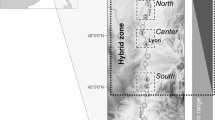Summary:
The identification of hybrids by high-precision stereomicroscopy and chorological data is described in detail by example of the ant species Formica bruni and pressilabris. In a synopsis of heterogenous data, the overall hybrid frequency in the ant fauna of Central Europe is estimated. 17 of the 164 ant species of this region are demonstrated and further 2 species strongly suspected to hybridise. The low-frequency hybridisers, showing overall hybrid ratios < 3%, were native elements of the Central European fauna before the onset of human cultivation and experienced direct interspecific contact for longer periods of their natural history. They developed more effective mechanisms of reproductive isolation beginning at the prezygotic level. Extremely high (12-31%) local hybridisation ratios occurred in species that invaded the area after anthropogenic changes in landscape structure. The segregated distribution of invaders and autochthonous species in the precultural period apparently did not impose the need to evolve more effective mechanisms for reproductive isolation. Prezygotic mechanisms in particular are deficient. In local situations, 19% of Lasius jensi matings and 44% of Leptothorax albipennis matings leading to successful nest foundations were matings with heterospecific partners. Signs for a dissolution of interspecific phenotypic differences are not detectable in most of the species. The dispersal of hybrid genotypes is apparently inhibited. Factors that probably stabilise the genomic integrity of hybridizing parent species are: (a) inability to produce hybrid queens (in L. jensi×umbratus), (b) aneuploidy of F1 females with inability to perform a balanced meiosis (in hybrids of L. albipennis with 3 other species), and (c) selection against hybrids in the epigenetic environment of alleles (Leptothorax nylanderi×slavonicus). Extreme ratios of heterospecific matings would mean a dangerous drain of genetic material. A mechanism to reduce these losses is postulated, consisting of a 'cleptogamy' (theft of heterospecific sperm) by queens that missed a conspecific male, an establishment of a functioning colony of F1 hybrid workers, a depression of the rearing or fertility of hybrid queens, and a maximum production of own sons by the queen. This mechanism could explain the persistence of rare species (Lasius jensi or Leptothorax albipennis) in an environment of more populous heterospecific hybridisation partners.
Similar content being viewed by others
Author information
Authors and Affiliations
Additional information
Received 8 December 1997; revised 16 March 1998; accepted 3 April 1998.
Rights and permissions
About this article
Cite this article
Seifert, B. Interspecific hybridisations in natural populations of ants by example of a regional fauna (Hymenoptera, Formicidae). Insectes soc. 46, 45–52 (1999). https://doi.org/10.1007/s000400050111
Issue Date:
DOI: https://doi.org/10.1007/s000400050111




